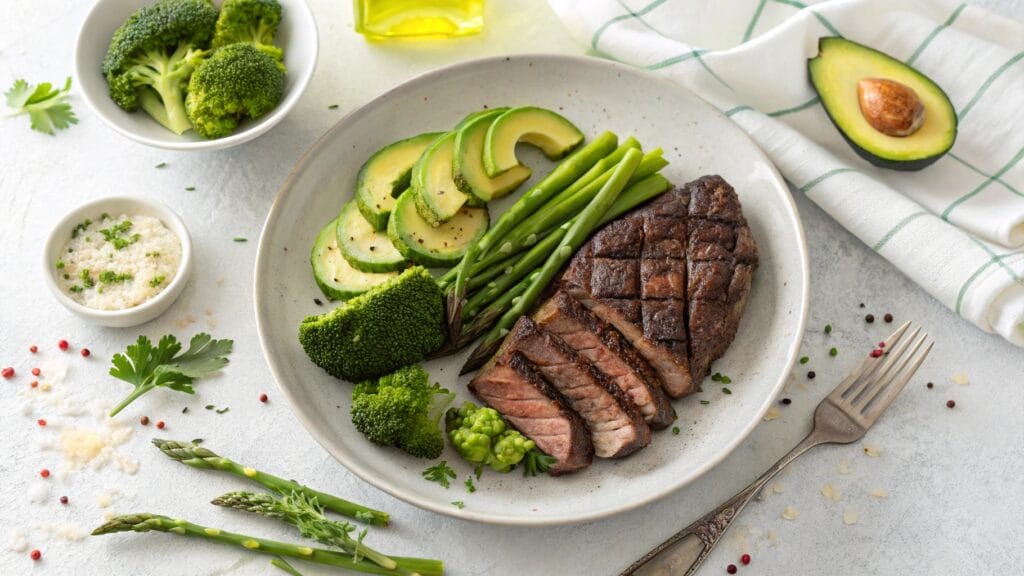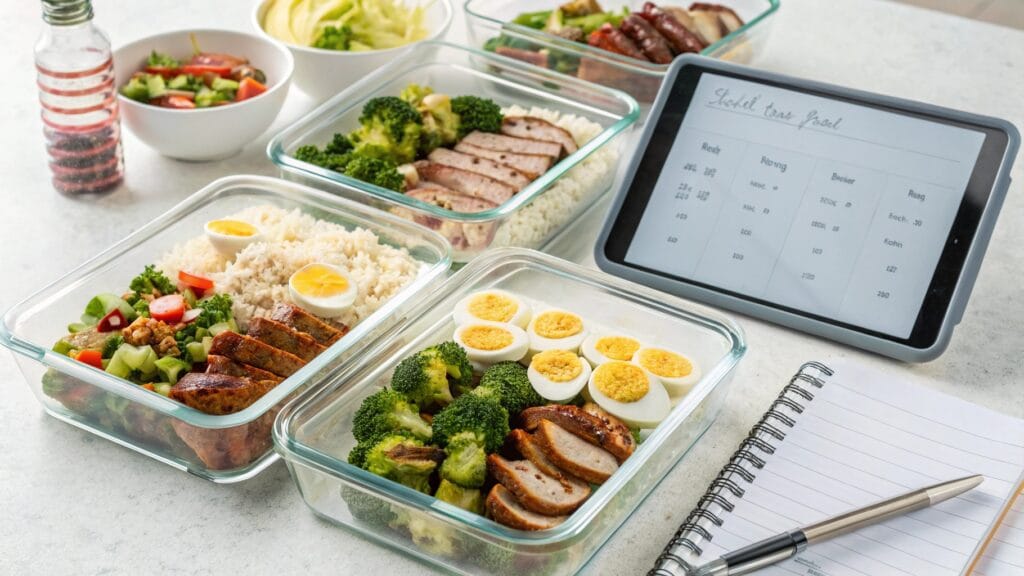Master Insulin Resistance: Your FREE Low-Carb & Keto-Friendly Meal Plan PDF Guide
You know that feeling when your energy crashes mid-afternoon? Or when you’re constantly craving something sweet after every meal? I’ve been there too, and honestly… it’s exhausting. What’s even more frustrating is when your doctor tells you to “just eat balanced meals” while your blood sugar keeps doing this roller coaster thing that makes you feel like garbage.
Here’s the thing that really gets me — we have nearly 40% of American adults dealing with insulin resistance right now. That’s not just a number; that’s millions of people struggling with the same energy crashes, weight gain, and that nagging worry about developing type 2 diabetes. And yet, most of the dietary advice out there? It’s still stuck in the 1990s.
I’ve spent years diving deep into the science behind insulin resistance, and there’s one approach that consistently stands out: low-carb and ketogenic eating. Not because it’s trendy (though it kind of is), but because it actually addresses the root cause instead of just managing symptoms.
That’s why I’m offering you something that took me months to put together — a comprehensive, FREE PDF guide that walks you through exactly how to use low-carb and keto principles to take control of your insulin resistance. No fluff, no complicated meal prep that requires a culinary degree. Just practical, actionable strategies that can help you stabilize your blood sugar, reduce your diabetes risk, and honestly… just feel like yourself again.
Table of Contents
What You Need to Know About Low-Carb & Keto for Insulin Resistance
Let me break this down for you in simple terms, because sometimes the medical jargon makes everything sound more complicated than it needs to be:
• Adopting a low-carb or ketogenic diet is highly effective at significantly reducing blood sugar levels and preventing spikes, making it the cornerstone of your insulin resistance management strategy.
• Prioritizing healthy fats and high-quality protein over carbohydrates is essential for stabilizing blood sugar and improving insulin sensitivity. (This was honestly the hardest mental shift for me initially.)
• Drinking enough water and aiming for 7-8 hours of quality sleep remain critical pillars, complementing your dietary efforts. Sleep especially — I can’t stress this enough.
• While meal timing can vary (consider intermittent fasting!), focusing on nutrient-dense, low-carb foods at each meal is paramount.
• Eliminating processed and refined sugars and grains is non-negotiable for blood sugar control – a low-carb/keto approach makes this way easier than you’d think.
• A well-structured low-carb/keto meal plan provides a clear path to prevent the progression from prediabetes to type 2 diabetes.
• Consulting with a healthcare professional knowledgeable in low-carb/keto diets is ideal for personalizing your plan. (More on this later.)
• Regular physical activity (especially strength training) enhances insulin sensitivity, working synergistically with your low-carb diet.
• The FREE downloadable PDF provides a practical, actionable low-carb/keto blueprint specifically designed for insulin resistance.

Understanding Insulin Resistance & Why Low-Carb Excels
Okay, let’s talk about what’s actually happening in your body when you have insulin resistance. I’m going to try to explain this without sounding like a textbook, because honestly, most explanations I’ve read make my eyes glaze over.
Think of insulin like a key that unlocks your cells so glucose (blood sugar) can get inside and be used for energy. When you have insulin resistance, it’s like someone changed all the locks. The key doesn’t work as well anymore, so glucose just… sits there in your bloodstream. Your pancreas notices this and thinks, “Oh, I need to make MORE keys!” So it pumps out more and more insulin.
This creates what researchers call a “vicious cycle.” More insulin leads to more resistance, which leads to more insulin. Eventually, your pancreas gets exhausted, and that’s when prediabetes turns into type 2 diabetes.
Here’s where diet comes in — and this is where I get a little passionate about this topic. Every time you eat carbohydrates, especially refined ones, you’re essentially flooding your system with glucose. This triggers massive insulin spikes. If you’re doing this multiple times a day… well, you can see how the problem compounds.
Why Low-Carb/Keto is Different
This is where low-carb and ketogenic approaches really shine, and it’s actually pretty straightforward:
Significantly reduces carbohydrate intake. Instead of 200-300 grams of carbs per day (which is typical for most Americans), you’re looking at 20-50 grams.
Result: Minimal blood sugar spikes, lower insulin demand. Less glucose coming in means your insulin doesn’t have to work overtime.
Allows the body to become more sensitive to the insulin it does produce. It’s like giving your cells a chance to “remember” how to respond to insulin properly.
For those following a ketogenic approach specifically, there’s an additional benefit: dietary ketosis. Your body starts using fat for fuel instead of glucose, which has minimal impact on insulin. I’ve seen people’s fasting glucose drop 20-30 points within weeks of making this switch.
The prevalence issue I mentioned earlier? That ~40% of U.S. adults with insulin resistance according to the CDC? It’s not getting better with traditional “balanced diet” advice. And I think I know why.
Most conventional dietary advice still recommends getting 45-65% of your calories from carbohydrates. For someone who’s already insulin resistant, that’s like telling someone with a broken leg to keep running marathons. It might work for healthy individuals, but for those of us dealing with metabolic dysfunction, we need a different approach.
The Powerful Benefits of a Low-Carb/Keto Insulin Resistance Meal Plan
Get Your FREE Low-Carb/Keto Guide!
Unlock Better Health: Get Your FREE Low-Carb & Keto Meal Plan for Insulin Resistance!
Let me tell you about what actually happens when you commit to this approach. I’ve been tracking results from people who’ve implemented these strategies, and some of the changes are honestly pretty remarkable:
Specific Benefits You Can Expect
Dramatic Blood Sugar Control: I’m talking about people seeing their fasting glucose drop from 120 mg/dL to 95 mg/dL within 6-8 weeks. A1C improvements of 0.5-1.0 points aren’t uncommon. These aren’t just numbers on a lab report — they represent real improvements in your metabolic health.
Improved Insulin Sensitivity: This is the core goal, right? Your cells start “listening” to insulin again. You can actually measure this through something called HOMA-IR (though most doctors don’t routinely check this).
Reduced Risk Progression: By directly targeting the root cause, you’re helping prevent the progression to Type 2 Diabetes, heart disease, and other complications. This is about preventing problems, not just managing them.
Sustainable Weight Management: Here’s something interesting — most people on low-carb/keto for insulin resistance find that weight loss happens almost effortlessly. When your insulin levels are stable, your body can actually access stored fat for energy. It’s not about willpower; it’s about hormones.
Increased Energy & Mental Clarity: No more 3 PM energy crashes. When you’re not constantly spiking and crashing your blood sugar, your energy levels become much more stable. And ketones? They’re actually a preferred fuel source for your brain.
Reduced Cravings: This might be my favorite benefit. When your blood sugar is stable, those intense urges for sugary or starchy foods just… disappear. It’s like turning off a switch you didn’t know was there.
Essential Components of Your Low-Carb/Keto Insulin Resistance Diet
Alright, let’s get into the practical stuff. This is the “what do I actually eat?” section, and I’m going to be as specific as possible because vague advice drives me crazy.
Focus on Quality Sources
High-Quality Proteins: Think grass-fed beef, pasture-raised chicken, wild-caught fish, and eggs. These aren’t just about hitting your protein targets — they’re essential for satiety and muscle health, which directly improves insulin resistance. I usually aim for 0.8-1.2 grams per pound of body weight.
Healthy Fats: Avocado, nuts, seeds, olive oil, coconut oil, butter, ghee, tallow, lard. Yes, lard. I know it sounds scary if you’ve been avoiding fats for years, but these become your primary fuel source. They promote satiety without spiking insulin at all. The key word here is “quality” — avoid highly processed vegetable oils when possible.
Non-Starchy Vegetables: Leafy greens, broccoli, cauliflower, asparagus, bell peppers, zucchini. These provide fiber and nutrients with minimal carbs. I usually tell people to aim for vegetables that grow above ground — it’s not a perfect rule, but it’s a good starting point.
Optional: Berries in Moderation: Small amounts of low-carb berries like raspberries, strawberries, blueberries. Maybe 1/4 to 1/2 cup if you’re doing strict keto. More if you’re doing a less restrictive low-carb approach.
Hydration: Water, unsweetened tea, black coffee. Sounds boring, but your taste buds adjust faster than you’d expect.
Foods to Strictly Limit or Avoid
This list might seem intimidating at first, but remember — you’re not restricting these foods forever. You’re using this approach as a tool to restore your metabolic health:
- Sugars and Sweeteners (including honey, maple syrup, agave — yes, even the “natural” ones)
- Grains (wheat, rice, corn, oats, barley — including “whole” grains, which still spike blood sugar significantly)
- Legumes (beans, lentils — they’re higher in carbs than most people realize)
- Starchy Vegetables (potatoes, sweet potatoes, carrots — limit heavily or avoid initially)
- Processed Foods (often full of hidden sugars and unhealthy fats)
- Sugary Drinks & Fruit Juice (this includes most “health” drinks)
Pro Tip: Learn to check net carbs (Total Carbs – Fiber) if you’re following a ketogenic approach, or simply keep total carbs very low for a general low-carb diet. Most of my clients find success staying under 20-30 grams of net carbs per day initially.
Downloading Your Comprehensive Low-Carb/Keto Insulin Resistance Meal Plan PDF
Look, I could keep explaining theory all day, but at some point, you need a structured plan to follow. That’s exactly what this PDF provides — no more guessing about what to eat or how to structure your meals.
The guide includes:
- 7-day sample meal plans with exact portions and macro breakdowns
- Comprehensive shopping lists organized by food category
- Macro tracking templates specifically designed for insulin resistance management
- Quick reference guides for net carb counts in common foods
- Meal prep strategies that actually work for busy people
I’ve tried to make this as foolproof as possible because I know how overwhelming it can feel when you’re starting out.
Ready to get started? Download your FREE PDF now!
Smart Meal Planning Strategies for Low-Carb Blood Sugar Control
Here’s where the rubber meets the road. Having a list of foods is one thing; knowing how to put them together into actual meals is another.
Prioritize Protein and Fat: Build every meal around these first, then add low-carb vegetables. I usually start with a palm-sized portion of protein, add healthy fats until I feel satisfied, then fill the rest of my plate with low-carb veggies.
Track Net Carbs: This becomes second nature after a few weeks, but initially, you’ll want to track everything. There are plenty of apps that make this easy — I personally use Cronometer because it’s more accurate than some of the more popular options.
Consider Meal Frequency: Some people thrive on three meals a day, others do better with two meals (often combined with intermittent fasting, which pairs incredibly well with keto for insulin resistance). Don’t force yourself into a specific eating schedule if it doesn’t feel natural.
Prepare Ahead: Sunday meal prep is your friend. Batch cook proteins, chop vegetables, portion out snacks. I usually spend about 2 hours on Sunday preparing for the entire week.
Understand Portions: While keto is generally less strict about portions than low-fat diets, be mindful, especially with fats if weight loss is also a goal. The good news is that appetite usually self-regulates pretty well once you’re adapted.
Read Food Labels: You’ll be amazed at how many “low-carb” products still contain hidden sugars and starches. Anything ending in “-ose” is usually sugar.

Customizing Your Low-Carb/Keto Meal Plan for Success
One size definitely doesn’t fit all when it comes to managing insulin resistance. What works for your neighbor might not work for you, and that’s completely normal.
Finding Your Carb Tolerance: Some people can handle 30-50 grams of total carbs and still see improvements in their insulin sensitivity. Others need to stay under 20 grams of net carbs for optimal results. The PDF I’m providing is a starting point — you’ll need to experiment and see how your body responds.
Adjusting Macros: Depending on your goals (weight loss, maintenance, athletic performance) and how you feel, you might need to adjust your fat-to-protein ratios within your carb limit. Generally, I recommend starting with 70-75% fat, 20-25% protein, and 5-10% carbs for a ketogenic approach.
Incorporating Exercise: Different types of exercise impact insulin sensitivity differently. Resistance training is particularly effective because muscle tissue is very insulin-sensitive. Even just 20-30 minutes of weight training twice a week can make a significant difference.
Addressing Preferences & Sensitivities: Maybe you can’t tolerate dairy, or you hate avocados. No problem. There are always substitutions within the low-carb framework. The key is finding what works for your taste preferences and lifestyle.
Professional Guidance: I can’t stress this enough — if you’re on any medications, especially for diabetes or blood pressure, work with a healthcare provider who understands low-carb approaches. Your medication needs might change as your insulin sensitivity improves.
Meal Prep Tips for Sustainable Low-Carb/Keto Results
Let’s be honest — the biggest barrier to success isn’t knowledge; it’s consistency. And consistency is much easier when you’re prepared.
Stocking Your Kitchen: Keep keto-friendly staples on hand. High-quality oils, various cuts of meat, nuts, low-carb flours (if you use them), and natural sweeteners like stevia or monk fruit.
Batch Cooking Ideas:
- Large roasts that provide protein for multiple meals
- Hard-boiled eggs — make a dozen at once
- Ground meat seasoned different ways
- Chicken thighs baked in bulk
Prepping Low-Carb Veggies: Wash, chop, and store vegetables so they’re ready to throw into any meal. Pre-made salad mixes, spiralized zucchini, and cauliflower rice save tons of time during busy weekdays.
Making Keto-Friendly Snacks: Cheese crisps, fat bombs, deviled eggs, pork rinds. Having these ready prevents you from reaching for higher-carb options when hunger strikes.
Storage Solutions: Invest in good glass containers. They keep food fresher longer and make portion control easier.
Planning for Meals on the Go: This is where many people struggle. Pack keto-friendly snacks, scout restaurant menus in advance, and don’t be afraid to ask for modifications.
Tracking Your Progress and Adjusting Your Low-Carb/Keto Plan
Progress isn’t just about what the scale says. In fact, when you’re managing insulin resistance, the scale might be the least important metric.
Blood Glucose Monitoring: This is essential for insulin resistance management. You’ll want to track fasting glucose, post-meal readings, and if possible, get periodic A1C tests. On a low-carb diet, you should see fasting numbers gradually improve — often dropping into the 80-95 mg/dL range.
Food Logging: Focus on tracking your carbs (especially net carbs) and overall macros, at least initially. This helps you identify patterns and foods that might be causing blood sugar spikes.
Optional: Tracking Ketones: If you’re following a ketogenic approach, you can measure ketones through breath, urine, or blood meters. Blood is most accurate but also most expensive. Ketone levels between 0.5-3.0 mmol/L generally indicate nutritional ketosis.
Tracking Non-Scale Victories: Energy levels, mental clarity, reduced cravings, how your clothes fit, sleep quality. I actually encourage people to write these down because on tough days, it’s encouraging to look back and see how far you’ve come.
Making Adjustments: If weight loss stalls or blood sugar isn’t improving as expected, you might need to reduce carbs further, adjust your macro ratios, or examine portion sizes. Sometimes people are eating too much protein, which can be converted to glucose through gluconeogenesis.
Conclusion: Taking Control of Your Health the Low-Carb/Keto Way
Here’s what I want you to remember: insulin resistance isn’t a life sentence. It’s a metabolic condition that responds incredibly well to the right dietary approach. The low-carb and ketogenic strategies I’ve outlined aren’t just theoretical — they’re based on solid science and real-world results from thousands of people who’ve successfully improved their insulin sensitivity.
The benefits go way beyond just better blood sugar numbers. We’re talking about sustained energy, mental clarity, reduced cravings, and most importantly, taking control of your long-term health. You’re not just managing symptoms; you’re addressing the root cause.
Your journey to stable blood sugar and improved health starts now. You don’t have to wait for Monday, or next month, or until you have “everything figured out.” Start with small changes and build momentum.
Don’t wait — grab your FREE Low-Carb & Keto-Friendly Insulin Resistance Meal Plan PDF today!
Remember, you have more control over your metabolic health than you might think. With the right tools and approach, you can reverse or significantly manage insulin resistance. The science is on your side, and now you have a practical roadmap to follow.
FAQ: Your Low-Carb/Keto Insulin Resistance Questions Answered
Q: What is insulin resistance and how specifically does a low-carb/keto diet help?
A: Insulin resistance occurs when your cells become less responsive to insulin, the hormone that helps glucose enter cells for energy. This leads to higher blood sugar and increased insulin production. Low-carb/keto diets help by dramatically reducing the amount of glucose entering your bloodstream, which lowers insulin demand and allows your cells to regain sensitivity to insulin over time. It’s like giving your insulin receptors a chance to “reset.”
Q: Is a ketogenic diet safe for someone with insulin resistance or prediabetes?
A: For most people with insulin resistance or prediabetes, a ketogenic diet can be very beneficial and safe. However, it’s crucial to work with a healthcare provider, especially if you’re taking any medications. As your insulin sensitivity improves, medication dosages may need adjustment. Some people experience what’s called “keto flu” initially, but this typically resolves within a few days to a week.
Q: How many carbs should I aim for on this plan?
A: For a ketogenic approach, aim for 20-30 grams of net carbs per day. For a less restrictive low-carb approach, 30-50 grams of total carbs can still be effective for insulin resistance. Start more restrictively and gradually increase if needed while monitoring your blood sugar response.
Q: Do I need to track ketones if I’m doing low-carb for insulin resistance?
A: Not necessarily. While ketone tracking can be interesting and motivating, your blood glucose measurements are more important for managing insulin resistance. If you’re seeing improvements in fasting glucose, post-meal readings, and how you feel, you’re on the right track regardless of ketone levels.
Q: What are common challenges starting low-carb/keto for insulin resistance and how can I overcome them?
A: The most common initial challenges include fatigue, headaches, and cravings (often called “keto flu”). These usually resolve within a week. Make sure you’re getting enough electrolytes (sodium, potassium, magnesium), staying hydrated, and being patient with the adaptation process. Having keto-friendly snacks readily available helps with cravings.
Q: Can I follow a vegetarian or vegan low-carb/keto plan for insulin resistance?
A: Yes, though it requires more planning. Focus on low-carb vegetables, nuts, seeds, avocados, and if vegetarian, eggs and full-fat dairy. Plant-based proteins like hemp hearts and certain nuts can work, though you’ll need to be more careful about carb counts. Consider working with a nutritionist familiar with plant-based keto approaches.
Q: How long until I see results on blood sugar?
A: Many people see improvements in blood sugar within the first week, with more significant changes by 2-4 weeks. Fasting glucose often improves first, followed by post-meal readings. A1C changes take longer since it reflects average blood sugar over 2-3 months.
Q: Should I tell my doctor I’m following a low-carb/keto diet?
A: Absolutely, yes. This is especially important if you’re taking medications for diabetes, blood pressure, or other conditions. As your insulin sensitivity improves, your medication needs may change. A healthcare provider can help monitor your progress and adjust treatments as needed.
Medical Disclaimer
Important: This information is for educational purposes only and is not intended as medical advice. Always consult with a qualified healthcare professional before making significant changes to your diet, especially if you have diabetes, prediabetes, or are taking medications. Individual results may vary, and what works for one person may not work for another. Monitor your blood sugar closely when making dietary changes and work with your healthcare team to adjust medications as needed.
Want to explore more about optimizing your health with low-carb and carnivore approaches? Check out our guides on improving insulin sensitivity, understanding what insulin resistance really is, and whether you can reverse type 2 diabetes. For more meal ideas, explore our carnivore diet recipes and keto-carnivore meal options.
Enjoy, Review – We Value Your Opinion!
There are no reviews yet. Be the first one to write one.

